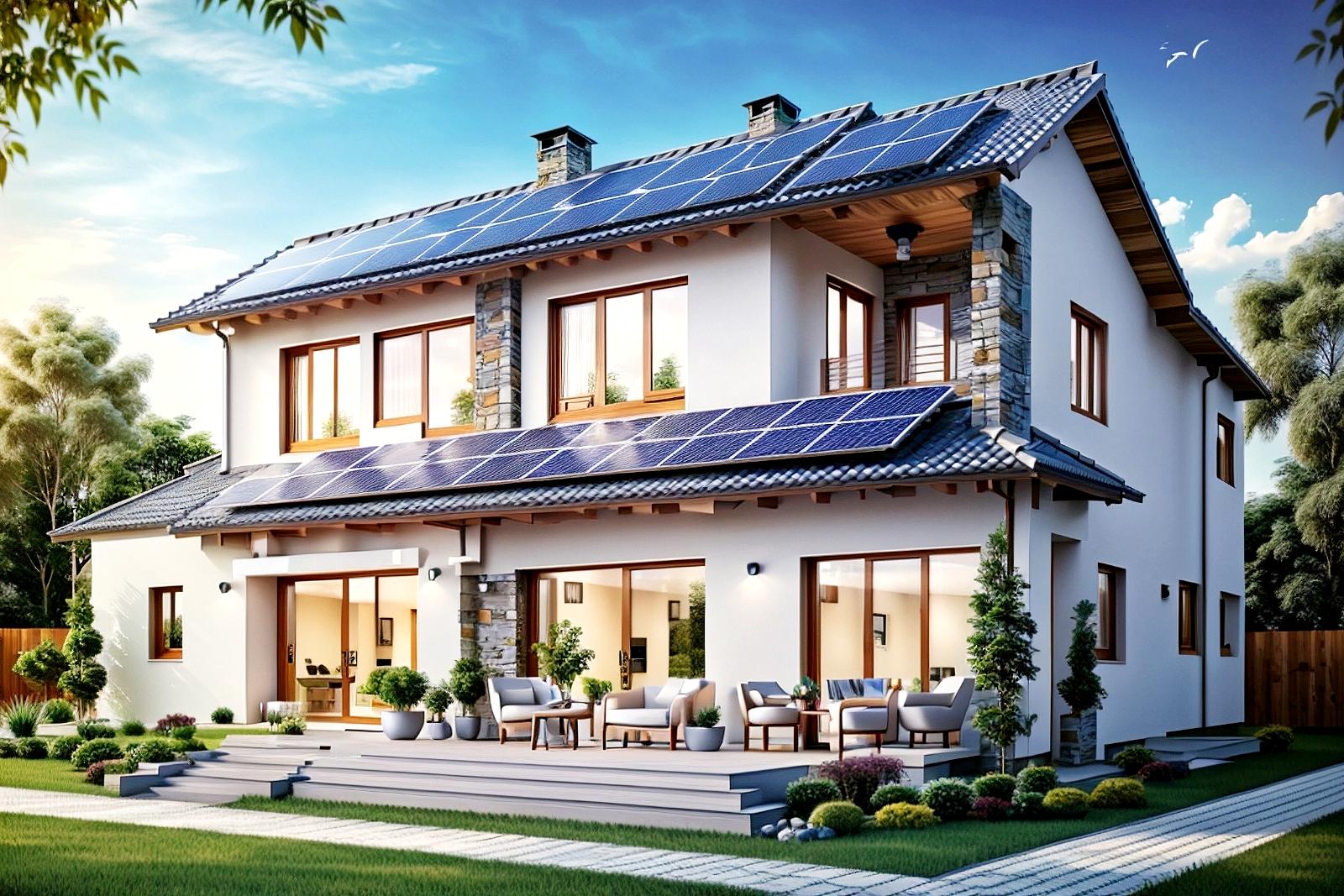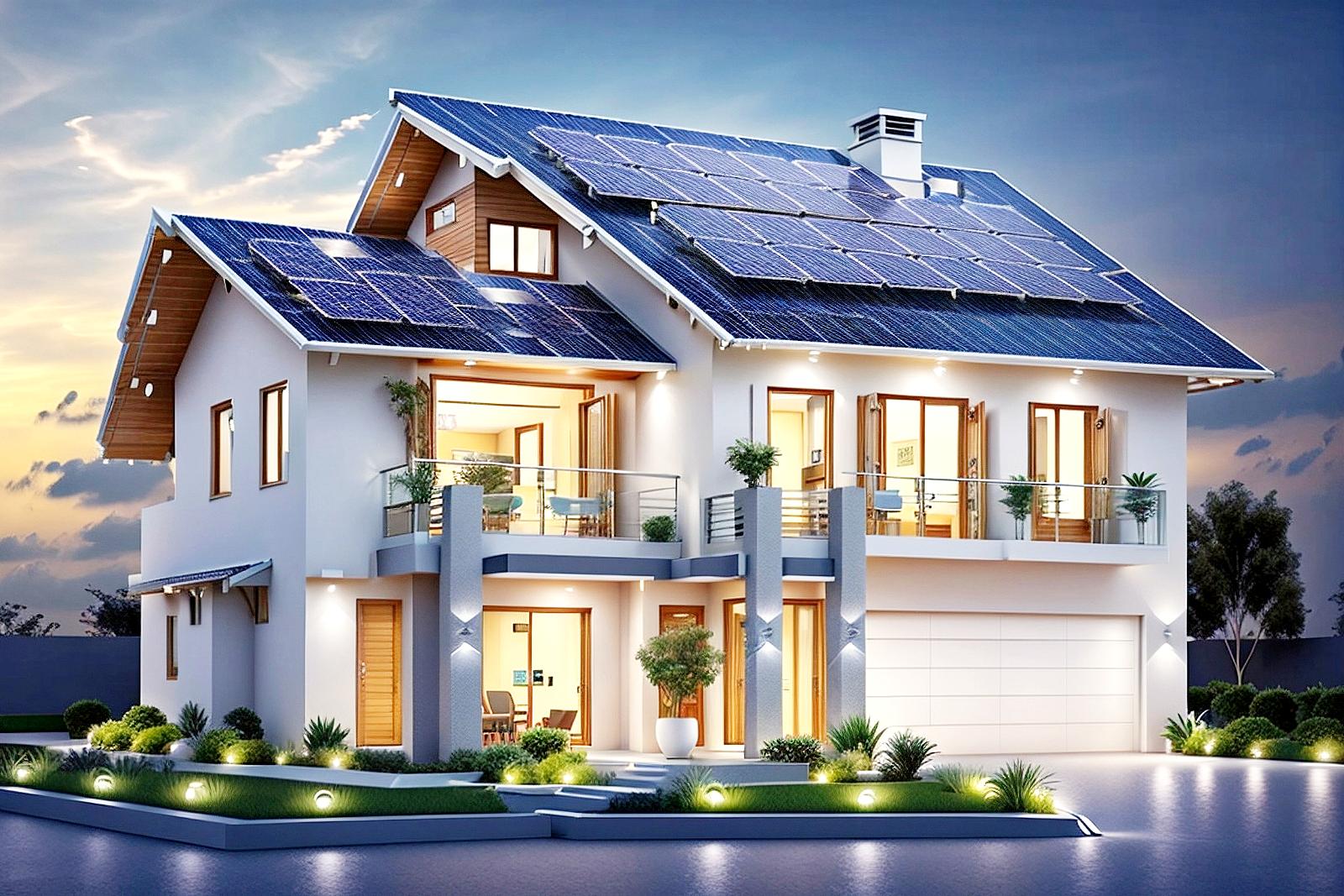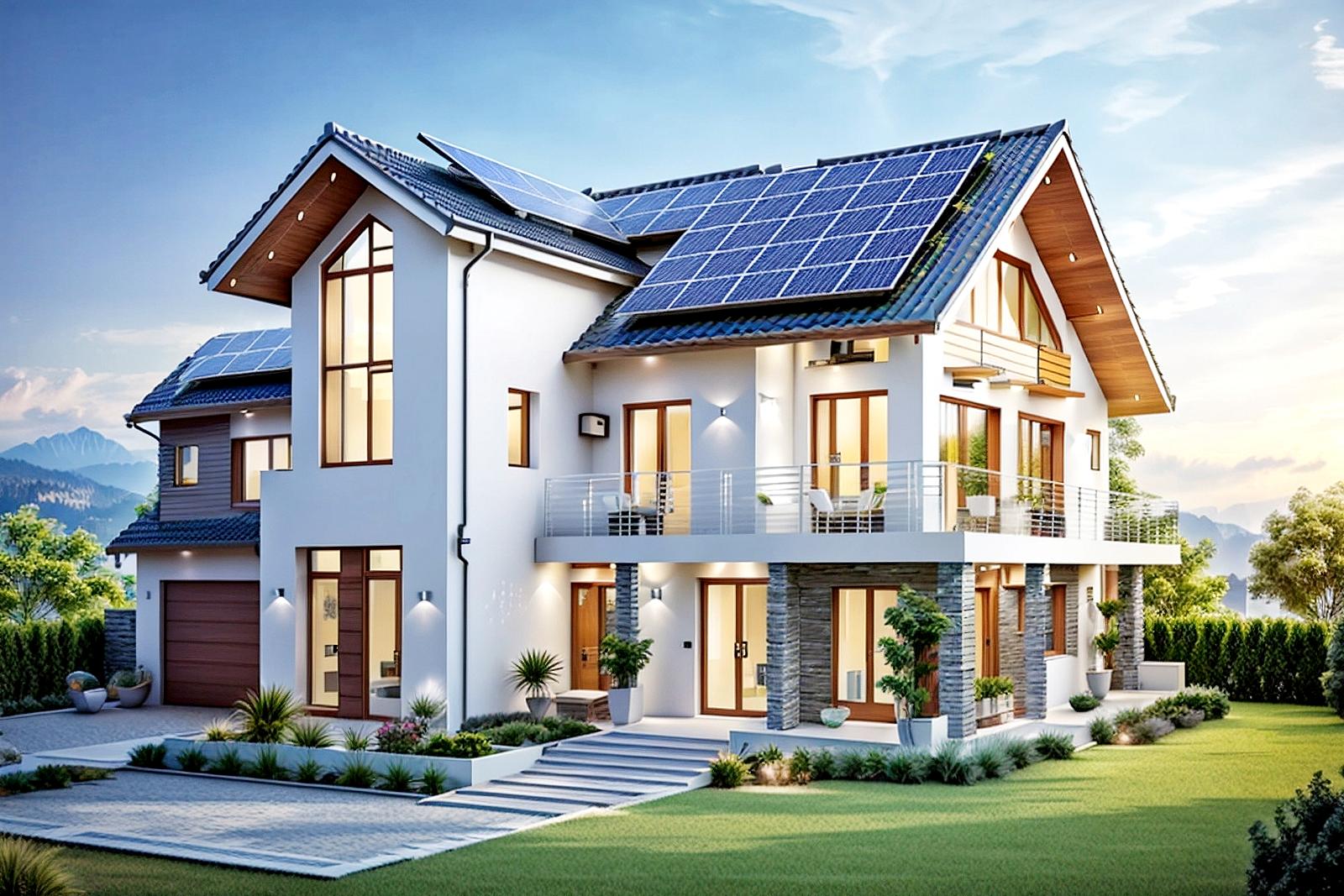- Benefits of Energy-Efficient Upgrades
- Solar Panels
- Insulation
- Energy-Efficient Appliances
- Smart Home Technology
Energy-efficient upgrades for homes refer to making improvements to a house's systems and features in order to minimize energy consumption and maximize energy-saving capabilities. Such upgrades can include insulation, sealing air leaks, installing energy-efficient appliances, switching to
LED lighting, and using renewable energy sources.
The significance of energy-efficient upgrades lies in their positive impact on the environment and energy consumption. Firstly, these upgrades reduce the amount of energy required to heat, cool, and power homes.
By minimizing energy usage, they help reduce greenhouse gas emissions, which are a significant contributor to climate change and global warming. In fact, residential buildings account for a substantial portion of energy consumption and carbon dioxide emissions in many countries.
Secondly, energy-efficient upgrades reduce dependence on fossil fuels and non-renewable energy sources. By focusing on improving energy efficiency, homeowners can lessen their reliance on conventional energy grids and instead switch to renewable energy alternatives like
solar panels or wind turbines.
This leads to a reduction in the consumption of fossil fuels, such as coal and natural gas, which are finite resources and contribute to air and water pollution. Moreover, energy-efficient upgrades can lead to substantial cost savings for homeowners.
By reducing energy consumption, individuals can significantly lower their utility bills over time, providing both short-term and long-term financial benefits. Additionally, government incentives and tax credits for energy-efficient upgrades further assist in offsetting the initial investment costs.
Furthermore, energy-efficient upgrades often enhance the comfort and indoor air quality of homes. Proper insulation and sealing of air leaks improve thermal comfort and reduce drafts.
Upgraded appliances and systems are also designed to operate with less noise and provide better air circulation, ventilation, and humidity control. These improvements contribute to healthier living environments for occupants.
Energy-efficient upgrades for homes are significant as they contribute to addressing environmental challenges, reducing energy consumption, saving costs for homeowners, promoting renewable energy sources, and improving the overall comfort and health of occupants.
The adoption of such upgrades is crucial for a sustainable future, where energy consumption is minimized, and the impact on the environment is reduced.
Table of contents
Benefits of Energy-Efficient Upgrades
First and foremost, energy-efficient upgrades provide a sigh of relief when it comes to monthly energy bills. By investing in improvements like insulation, energy-efficient windows and doors, high-efficiency HVAC systems, and LED lighting, you can save a substantial amount of money over time.
Reduced Dependence on Traditional Energy Sources:
By harnessing solar power, you can considerably reduce your reliance on fossil fuels, thus minimizing the negative environmental impact associated with traditional energy sources.
Embracing solar energy contributes to the reduction of greenhouse gas emissions, helping mitigate climate change. Additionally, utilizing solar power empowers individuals and communities to become energy independent, as the sun is an abundant and renewable resource available to all.
Long-term Cost Savings:
One of the most compelling reasons for installing solar panels is the potential for substantial cost savings in the long run. While the initial investment might seem significant, solar panels have a lifespan of approximately 25-30 years and require minimal maintenance.
By generating your own electricity, you can significantly reduce or even eliminate your monthly electricity bills. Additionally, net metering programs in many regions allow you to receive credits or even monetary compensation for excess electricity produced, further offsetting costs.
Potential Incentives and Tax Credits:
Governments and energy organizations worldwide recognize the importance of transitioning to clean energy sources. With this in mind, they often provide incentives or tax credits to encourage individuals and businesses to adopt solar power.
These incentives can include investment subsidies, rebates, performance-based incentives, or tax credits. Researching the incentives available in your region can help make solar panel installation even more financially attractive.
Types of Solar Panels and Installation Process:
When it comes to solar panels, there are primarily two types: monocrystalline and polycrystalline. Monocrystalline panels are made of a single crystal structure, making them highly efficient but costlier. Polycrystalline panels, on the other hand, are made from multiple crystal fragments, offering slightly lower efficiency but a more cost-effective solution.
The installation process typically involves the following steps:
1. Site assessment: Evaluating the location's solar potential, including sun exposure and structural integrity.
2. System design: Determining the size and layout of the solar panel system based on your energy consumption and available roof space.
3. Permits and paperwork: Ensuring compliance with local regulations by obtaining necessary permits and documentation.
4. Installation: Mounting the solar panels on the roof or ground, connecting them to an inverter, and integrating the system into your electrical setup.
5. Grid connection: Coordinating with your utility company to link the solar panel system to the power grid.
6. Inspection and activation: Finalizing the installation process through inspections and the activation of your solar power system.
Considerations for Choosing the Right System:
Selecting the appropriate solar panel system requires careful consideration of various factors such as:
1. Energy requirements: Assess your household or business's energy needs to determine the size and capacity of the system.
2. Available space: Evaluate the available roof area or ground space to determine the best fit for your solar panel installation.
3. Budget: Consider your financial resources and determine the optimal balance between upfront costs and long-term savings.
4. System warranty and durability: Ensure the chosen solar panels come with adequate warranties and are built to withstand challenging weather conditions.
Maintenance, Durability, and Warranty:
Solar panels are designed to require minimal maintenance, primarily involving periodic cleaning to remove dust or debris. The durability of solar panels can vary, but most manufacturers provide warranties ranging from 25 to 30 years, assuring long-term performance and reliability. However, it is important to choose reputable manufacturers and installers to maximize the benefits of your solar panel investment.
Embracing solar power through the installation of solar panels offers a multitude of benefits, including reduced dependence on traditional energy sources, long-term cost savings, and potential incentives or tax credits.
By understanding the available types of solar panels, considering key factors during the installation process, and adhering to recommended maintenance practices, you can make an informed decision and unlock the full potential of clean and renewable solar energy. Start harnessing the power of the sun today and contribute to a greener, more sustainable future.
Table of contents
The Essential Role of Proper Insulation in Enhancing Energy Efficiency and Reducing Heating/Cooling Costs
Efficient insulation serves as an invaluable asset in minimizing energy consumption and maximizing savings on heating and cooling expenses.
1. The Importance of Proper Insulation:
Proper insulation acts as a thermal barrier, preventing heat transfer between the interior and exterior environments. By sealing the building envelope, insulation significantly enhances energy efficiency and reduces heating and cooling costs. It minimizes temperature fluctuations and increases comfort levels, ensuring optimal living or working conditions throughout the year.
2. Different Insulation Materials and Their Pros and Cons:
- Fiberglass:
One of the most commonly used materials for insulation, fiberglass offers good thermal resistance, is fire-resistant, and has a long lifespan. However, it can irritate the skin, eyes, and lungs during installation, requiring protective measures.
- Foam:
Rigid foam insulation, such as expanded polystyrene (EPS), provides excellent insulation properties and moisture resistance. It is ideal for insulating foundations, walls, and roofs. However, its higher cost and the need for professional installation may limit its suitability for certain projects.
- Cellulose:
Made from recycled paper or plant fibers, cellulose insulation is eco-friendly, provides effective thermal performance, and is capable of filling small gaps and voids. It requires professional installation to ensure proper coverage and may require additional fire-retardant treatment.
3. Assessing Insulation Needs:
- Conduct an energy audit:
Identify areas of heat loss or gain, such as drafty windows, poorly insulated walls, or insufficient attic insulation. Consider hiring a professional auditor or using DIY tools like infrared cameras or thermal sensors.
- Gauge current insulation levels:
Determine the thickness and R-value (insulation's resistance to heat flow) of existing insulation. Measure its condition and determine if additional insulation is needed to meet recommended levels based on your local climate.
4. Finding Professional Installers:
- Seek recommendations and referrals:
Ask friends, family, or neighbors who have recently completed insulation projects for their experiences and recommendations. Research local contractors' trade associations and check online reviews.
- Verify credentials and experience:
Ensure the installer is licensed, insured, and bonded. Inquire about their experience with similar projects and request references to assess their quality of work.
5. Ensuring Compliance with Building Codes:
- Familiarize yourself with local codes:
Research the insulation requirements specified by your local building authority. Be aware of any specific materials, R-values, or installation methods mandated to meet your area's standards.
- Request necessary certifications:
Insist on written documentation or certificates of compliance from installers to ensure that the work meets the applicable building codes and regulations.
Proper insulation significantly improves energy efficiency, lowers heating/cooling costs, and enhances overall comfort. By understanding different insulation materials, assessing needs accurately, finding reputable installers, and complying with local building codes, you can ensure a successful insulation project.
Table of contents
Energy-Efficient Appliances
Upgrading to energy-efficient appliances offers a wide array of benefits that go beyond just saving money on utility bills. With advancements in technology, energy-efficient appliances such as refrigerators, washing machines, air conditioners, and water heaters showcase a significant improvement in performance while reducing environmental impact.
By making these upgrades, not only can you enjoy numerous advantages, but you can also contribute to a greener and more sustainable future.
One major certification to consider when purchasing energy-efficient appliances is ENERGY STAR. Endorsed by the Environmental Protection Agency (EPA) and the Department of Energy (DOE), ENERGY STAR certification ensures that the appliance meets strict energy efficiency guidelines. This certification helps consumers in making informed decisions and provides them with reliable information about the energy performance of the product.
The benefits of upgrading to energy-efficient appliances:
1. Cost savings:
The most apparent benefit of energy-efficient appliances is the potential savings on your utility bills. Due to their advanced technology and improved efficiency, these appliances consume less energy, resulting in lower electricity and water bills. Replacing an old refrigerator with an ENERGY STAR certified model, for instance, can save you up to $300 over the appliance's lifetime.
2. Environmental impact:
Energy-efficient appliances significantly reduce greenhouse gas emissions by consuming less energy. By replacing an old refrigerator with an ENERGY STAR certified one, you can reduce carbon dioxide emissions by around 9,500 pounds over the appliance's lifetime. Such environmentally-friendly choices help combat climate change and promote a cleaner environment.
3. Enhanced performance:
Energy-efficient appliances often come with more advanced features and technologies that improve their overall performance. For example, efficient washing machines have larger capacities, shorter cycle times, and better cleaning results. Similarly, energy-efficient air conditioners provide better cooling with minimal noise and humidity control features.
4. Longer lifespan:
When you upgrade to energy-efficient appliances, you're investing in quality. These appliances are built to higher standards and are often more durable than their inefficient counterparts. Although they may require a larger upfront investment, the potential savings on repairs and replacements in the long run outweigh the initial cost.
5. Incentives and rebates:
Many utility companies and government entities offer incentives and rebates for purchasing energy-efficient appliances. These financial incentives can further reduce the cost of upgrading, making energy-efficient options even more attractive and affordable.
When shopping for energy-efficient appliances, look for the ENERGY STAR label as a reliable indicator of energy efficiency. It is essential to check the specific energy consumption and estimated savings before making a purchase, as different models may vary in efficiency.
Upgrading to energy-efficient appliances is not only a smart financial decision but also a responsible environmental choice. By reducing energy consumption, these appliances contribute to a more sustainable future while providing superior performance and potential cost savings.
Table of contents
Smart Home Technology
Have you ever wished your home could think for itself and save you both time and money? Well, thanks to
smart home technology, this is now a reality. Smart home technology utilizes various devices and systems to automate and control different aspects of your home, making your life easier while also promoting energy efficiency.
One of the key components of a smart home is a smart thermostat. Unlike traditional thermostats that require manual adjustments, smart thermostats learn your schedule and preferences to automatically optimize your heating and cooling settings.
This means that when you leave for work, the thermostat will adjust the temperature to save energy, and when you're on your way home, it will have your house at the perfect temperature for your arrival. By eliminating unnecessary heating or cooling, smart thermostats can help reduce your energy consumption and lower your utility bills.
Another aspect of smart home technology that contributes to energy efficiency is automated lighting. Automated lighting systems allow you to control your lights from anywhere using your smartphone or voice commands.
They can be programmed to automatically turn off lights when no movement is detected in a room, or to adjust the brightness according to the natural light available. By ensuring that lights are only on when needed, you can significantly reduce your energy usage and contribute to a greener environment.
Energy monitoring systems are yet another valuable tool in optimizing energy usage in your smart home. These systems provide real-time data on your energy consumption, allowing you to identify areas where you can make changes to conserve energy.
For example, you can monitor how much energy your appliances are using and find ways to run them more efficiently. By understanding your energy usage patterns, you can make informed decisions that can lead to significant energy savings over time.
Beyond the energy-efficient benefits, integrating smart home technology into your existing systems brings a newfound convenience to your everyday life.
Imagine being able to control your thermostat, lighting, and appliances from anywhere, whether you're lying in bed or miles away from home. With just a few taps on your smartphone, you can ensure that your home is comfortable and energy-efficient even when you're not there.
Smart home technology offers homeowners the opportunity to optimize their energy usage, reduce their carbon footprint, and enjoy the convenience of controlling their home from anywhere. From smart thermostats to automated lighting and energy monitoring systems, these devices and systems can work harmoniously to make your home energy-efficient while simplifying your life.
Table of contents



